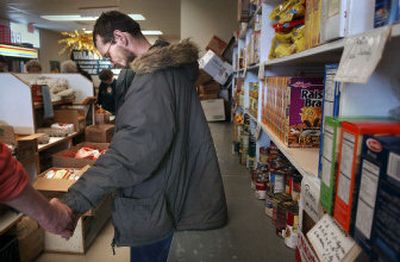Food bank copes with change

This isn’t the food bank you remember.
It’s not a musty church basement with stacked cans of creamed corn on shelves. At Second Harvest Inland Northwest it’s a warehouse, where tons of food, much of it fresh fruits and vegetables, pass through every day and are tracked with advanced computer systems.
But in a region where many food banks are still in church basements, adapting to handle fresh foods is a major challenge.
“You have these traditions that food banks have been operating on for 15 to 20 years,” said Jason Clark, executive director of Second Harvest. “How do we get the change to the neighborhood food banks? Sometimes that’s not an easy thing even if they have the desire to do it.”
In the Spokane Valley Food Bank, part of a wing of an old church has shelves filled with cans and a freezer full of turkeys – but when the Second Harvest truck pulls up with fresh produce, there is no place to store it.
Instead, produce is served out of the truck or is put on tables in the food bank.
Director Barbara Bennett said she knows change is needed at the food bank, which opened in 1972, but costs and a lack of volunteers can be a hindrance.
Gonzaga University engineering students are working on plans to reorganize the facility or build some additions, particularly to keep patrons from waiting outside in a line to get their food, Bennett said. The food bank is also looking at buying a commercial refrigerator to house perishable food.
The look to the future comes at the same time as the Valley Food Bank merges with the Spokane Valley Community Center. Lawyers are still working out the details; both boards are expected to approve the merger after months of discussion, Bennett said.
The organizations’ boards of directors will merge, and the two entities that have been housed under the same roof for years will become one.
“Hopefully we will move toward a consensus on best practices for our families,” said SVCC Director Mollie Dalpae.
Bennett, who has worked as the director at the food bank for more than 12 years, said she hopes the merger doesn’t make drastic changes in the way the food bank is run.
“We don’t want to see anything happen like starting over and doing everything different,” she said. “We feel we’re an exceptional organization, and we’d like to stay like that.”
But in a way, food banks across the region will have to find ways to adapt to drastic changes.
For years, food banks have worked with nonperishable foods because of a long shelf-life and easy storage. Nonprofits like Second Harvest coordinated with food industry suppliers to take overstock and extra inventory.
But as technology advances, supermarkets and industry supplies have become more efficient at keeping their inventory losses low, which can spell bad news for food banks, Clark said.
Instead of the bedrock foundation of dried foods, Second Harvest now tries to collect extra produce from area supermarkets, Clark said. In 1997 Second Harvest handled 200,000 pounds of fresh produce; in 2006 that number increased 25 times to 5 million pounds.
“In three to five years, 70 to 90 percent of our supply will be perishable foods,” Clark said. “That impacts how neighborhood food banks operate.”
Area food banks are looking at many ways to adapt, Clark said. Some are trying to find refrigerators, and others are implementing a self-selection process, in which clients choose their own food needs with certain restrictions in place. Some are looking to different hours to try and keep a good flow of people moving through. Above all, food banks and Second Harvest will need to find ways to share a solution, he said.
“We’re going to have to find a way where food banks change their operations to make supply meet demand,” Clark said. “It’s clear everyone has the best intentions, but some people have a traditional way they work and sometimes they don’t want to change that.”
And the need for food isn’t dropping.
About 197,000 people each year use the 300 food banks scattered throughout the Inland Northwest. In 1997, Second Harvest distributed about 5 million pounds of food. Last year that amount nearly tripled to 14.8 million pounds.
The Valley Food Bank averages about 800 families each month, Bennett said, and that number has been growing for years.
With changes looming, Bennett said no matter what happens, people will still get the food they need.
“We’re all about serving the families that come to us,” she said. “Anything that will benefit them, we’re for.”